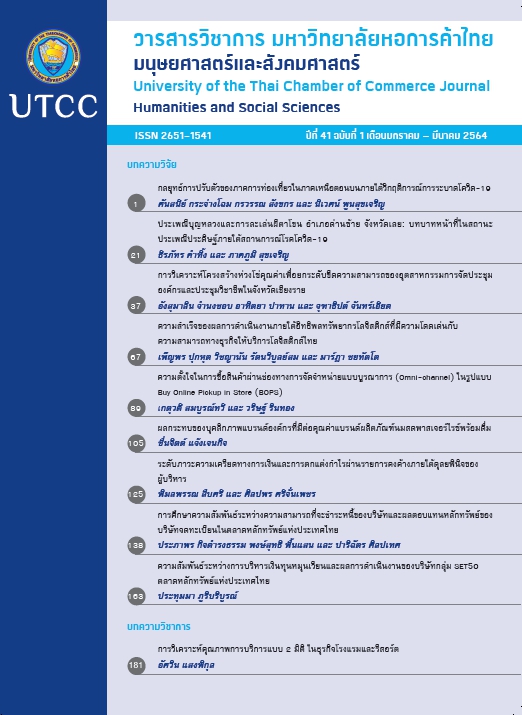Level of Financial Distress and Accruals-Based Earnings Management
Main Article Content
Abstract
This research examines the relation between level of financial distress and accruals-basedearnings management. All firms in the sample are listed company in the Stock Exchange of Thailand(SET) over the period 2011-2015. The level of financial distress is measured by Altman’s EM – ScoreModel (Altman, Hartzell, & Peck, 1995) and accruals-based earnings management is measured
by Kothari’s Performance-Matching Model (Kothari, Leone, & Wasley, 2005). The research foundthat level of financial distress is significantly negative with accruals-based earnings management.Distressed firms have lower accruals-based earnings management than non-distressed firms thatare grey zone firms and healthy firms. Non-distressed firms engage in earnings management to
avoid being classified as distressed firm or for management’s interest. The value gained from
the research is to remind investors and users of financial statements of the financial report’sreliability. They should be careful when making decisions and be aware of the possibility thathealthy companies might be engaging in earnings management and show no signs of financial
distress. The relevant regulators should consider and establish laws and regulations to ensure the accuracy and reliability of financial information reported by the companies.
Article Details

This work is licensed under a Creative Commons Attribution-NonCommercial-NoDerivatives 4.0 International License.
ลิขสิทธิ์ของบทความ
ผลงานที่ได้รับการตีพิมพ์ถือเป็นลิขสิทธิ์ของมหาวิทยาลัยหอการค้าไทย ห้ามมิให้นำเนื้อหา ทัศนะ หรือข้อคิดเห็นใด ๆ ของผลงานไปทำซ้ำ ดัดแปลง หรือเผยแพร่ ไม่ว่าทั้งหมดหรือบางส่วนโดยไม่ได้รับอนุญาตเป็นลายลักษณ์อักษรจากมหาวิทยาลัยหอการค้าไทยก่อน
References
กฤษณา กัมปนาทโกศล, และ ชาญชัย ตั้งเรือนรัตน์. (2551). การตกแต่งกำไรกับสัดส่วนการก่อหนี้. วารสารวิชาชีพบัญชี, 4(10), 66-78.
ณัฎฐยา เพชรล่อเหลียน. (2553). การศึกษาความสัมพันธ์ระหว่างโอกาสในการล้มละลายและการล้มละลายของบริษัทจดทะเบียนในตลาดหลักทรัพย์แห่งประเทศไทย (การศึกษาอิสระปริญญามหาบัณฑิต ไม่ได้ตีพิมพ์). มหาวิทยาลัยธรรมศาสตร์, กรุงเทพฯ.
ประเสริฐ ลีฬหาวาสน์, และ มนวิกา ผดุงสิทธิ์. (2552). การพยากรณ์ภาวะล้มเหลวทางธุรกิจจากข้อมูลทางบัญชี. วารสารวิชาชีพบัญชี, 5(13), 65-82.
ภัศรา พิริยมานันท์. (2554). ความสัมพันธ์ระหว่างความเครียดทางการเงินกับคุณภาพกำไรของบริษัทจดทะเบียนในตลาดหลักทรัพย์แห่งประเทศไทย (การศึกษาอิสระปริญญามหาบัณฑิต ไม่ได้ตีพิมพ์). มหาวิทยาลัยธรรมศาสตร์, กรุงเทพฯ.
Altman, E. (1968). Financial ratios, discriminant analysis and prediction of corporate bankruptcy. Journal of Finance, 23(4), 589-609.
Altman, E., Hartzell, J., & Peck, M. (1995). Emerging markets corporate bonds: A scoring system. New York, NY: Salomon Brothers.
Asquith, P., Gertner, R., & Sharfstein, D. (1994). Anatomy of financial distress: An examination of junk bond issuers. The Quarterly Journal of Economics, 109(3), 625-658.
Beaver, W. H. (1966). Financial ratios as predictors of failure. Journal of Accounting Research, 4, 71-111.
Becker, C. L., Defond, M. L., Jiambalvo, J., & Subramanyam, K. R. (1998). The effect of audit quality on earnings management. Contemporary Accounting Research, 15(1), 1-24.
DeAngelo, H., DeAngelo, L., & Skinner, D. (1994). Accounting choice in troubled companies. Journal of Accounting and Economics, 17(1-2), 113-143.
Dechow, P. M., Sloan, R. G., & Sweeney, A. P. (1995). Detecting earnings management. The Accounting Review, 70(2), 193-225.
Demirkan, S., & Platt, H. (2009). Financial status, corporate governance quality, and the likelihood of managers using discretionary accruals. Accounting Research Journal, 22(2), 93-117.
Ghazali, A. W., Shafie, N. A., & Sanusi, Z. M. (2015). Earnings management: An analysis of opportunistic behavior, monitoring mechanism and financial distress. Procedia Economics and Finance, 28, 190-201.
Jones, J. (1991). Earnings management during import relief investigations. Journal of Accounting Research, 29(2), 193–228.
Jones, K. L., Krishnan, G. V., & Melendrez, D. (2008). Do models of discretionary accruals detect actual cases of fraudulent and restated earnings? An empirical analysis. Contemporary Accounting Research, 25(2), 499-531.
Kothari, S. P., Leone, A. J., & Wasley, C. E. (2005). Performance matched discretionary accrual measures. Journal of Accounting and Economics, 39(1), 163-197.
Leuz, C., Nanda, D., & Wysocki, P.D. (2003). Earnings management and investor protection: An international comparison. Journal of Financial Economics, 69(3), 505-527.
Liberty, S., & Zimmerman, J. (1986). Labor union contract negotiations and accounting choice. The Accounting Review, 61(4), 692-712.
Rosner, R. L. (2003). Earnings manipulation in failing firms. Contemporary Accounting Research, 20(2), 361-408.


